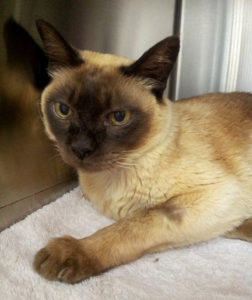Some people are surprised to hear when their dog or cat is diagnosed with diabetes. Symptoms in dogs and cats can be similar to those in humans: weight loss, excessive drinking and urination. Diabetes is caused by insulin shortage, so that glucose cannot be converted into energy in the body.
Diabetes is a treatable condition and need not shorten your pet’s lifespan or affect their quality of life. However, if diabetes is left untreated, there can be many severe side effects, including weakness in the legs, malnutrition and dehydration, which can lead to death.
Immediately after diabetes is diagnosed, your pet may need to spend a few days in hospital to stabilise his or her condition. However after this, treatment is generally less intensive, involving once or twice daily insulin injections. This is a very small injection under the skin, and most dogs and cats tolerate it very well.

Ballou is a cat with diabetes who is visiting us in hospital to check his blood sugar levels throughout the day. Ballou hides out in his cubby, watching the goings-on in hospital, and every 2 hours comes out for lots of cuddles and pats, and a quick blood sugar check. This is similar to how humans check their blood sugar level from a pinprick of the finger.
Regular monitoring of blood sugar levels in diabetic pets is vitally important to ensure we are giving them the right dose of insulin to properly control their diabetes.
If you are concerned that your dog or cat is losing weight (even though they’re eating well and not on a diet), or is drinking or urinating more, bring them in for a check up with one of our vets.
Posted on 19 December 2013
Last updated on 12 December 2019
Tagged with: diabetes



